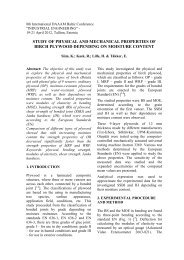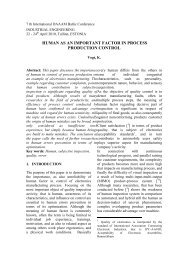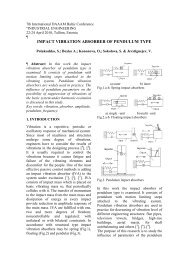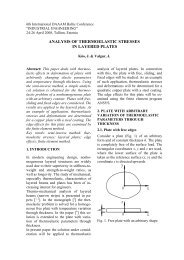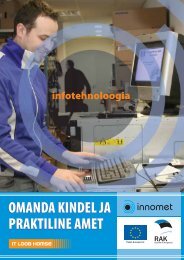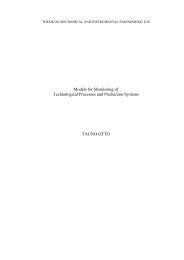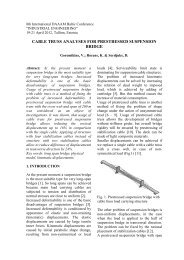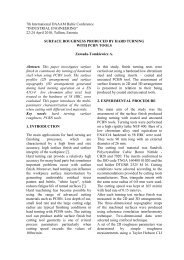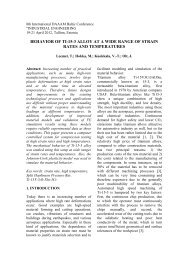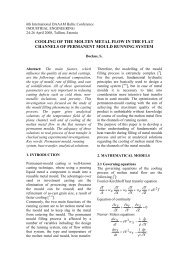DIAGNOSTICS OF DRUM TYPE WOOD SHREDDER MACHINES
DIAGNOSTICS OF DRUM TYPE WOOD SHREDDER MACHINES
DIAGNOSTICS OF DRUM TYPE WOOD SHREDDER MACHINES
You also want an ePaper? Increase the reach of your titles
YUMPU automatically turns print PDFs into web optimized ePapers that Google loves.
Currently measurements are being taken atregular intervals to reflect changes in theblade and supporting blade interactionduring working process. This is achievedby measuring the gap between the bladeand supporting blade at three points, once aday (figure 4, points A, B, C). Thesereadings show both the progress ofsupporting blade deflection and total wearon the blade and supporting blade. As thein-situ experimental process is currently inthe initial stage, the amount of gathereddata is insufficient to give a statisticallyreliable description of wear progress or todevelop a mathematical model thatdescribes this process.Up-to-date results relate to shreddingmachine working principle research andanalysis, defining actual workingcharacteristics and calculations. At thispoint, the main constructive improvementsfor the shredding machine have beendefined, mentioning that further study cannot take place without these improvements.The most problematic and importantjunction points have been defined, whichrequire new service technology consistingof regular junction condition follow-up anda diagnostic-based maintenance system.6. FURTHER RESEARCHThe next stage is to summarize blade andsupporting blade interaction measurementdata and place sensors under the supportingblade (figure 4). By setting up load sensors,it will be possible to follow-up and analyzeover time the effect of increasing loads onthe supporting blade.Following this, we shall define therelationship between the blade andsupporting blade reciprocal wear conditionand load sensor data, which in future willmake it possible to perform indirect bladesupportingblade monitoring, based on loadsensor measurement data. As a result ofresearch, it is planned to develop aprogramme that will automatically signalwhen there is a need for facilitymaintenance or terminate operation of thefacility, if necessary.11. REFERENCES1. Bershadsky A. L., Rezanie drevesini,Vishaia shkola, Мinsk, 19752. Tuherms H., Kokapstrādes instrumenti,Zvaigzne, Riga, 19853. Holmberg, K., Helle, A. & Halme, J.,Prognostics for Industrial MachineryAvailability, presented at the InternationalSeminar on Maintenance, ConditionMonitoring and Diagnostics, Oulu (FI), 28-29th September 20054. Kalpakjian S. and Schmid, S. R.,Manufacturing Engineering andTechnology, Pearson Education Ltd.,London, 20065. Measurement and control tools [WWW],http://www.ge-mcs.com/en/bently-nevadasensors-and-transducers.html.(22.02.2012)7. CORRESPONDENCE ADDRESSMSc.ing. Marcis ZarinsRTU, Faculty of Transport and MechanicalEngineering, Department of MaterialProcessing Technology,Ezermalas 6, LV-1006 Riga, LatviaPhone: +37126113009E-mail: marciszarins@gmail.comFigure 4. Measurement scheme243



